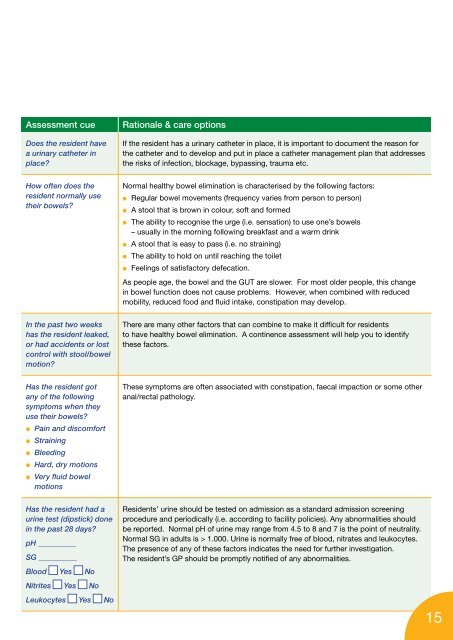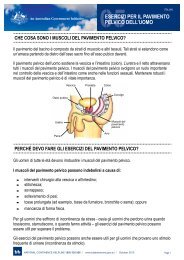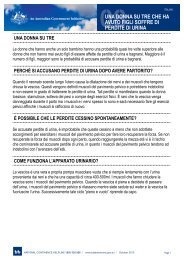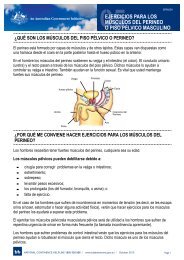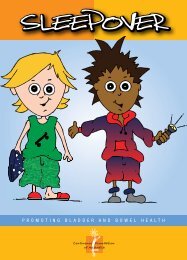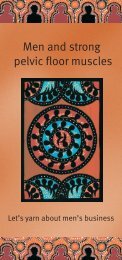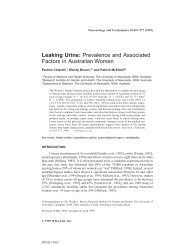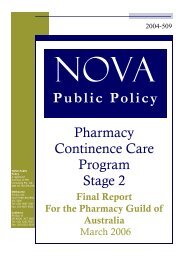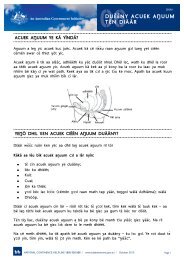Continence Tools for Residential Aged Care - Bladder and Bowel ...
Continence Tools for Residential Aged Care - Bladder and Bowel ...
Continence Tools for Residential Aged Care - Bladder and Bowel ...
You also want an ePaper? Increase the reach of your titles
YUMPU automatically turns print PDFs into web optimized ePapers that Google loves.
Assessment cue Rationale & care options<br />
Does the resident have<br />
a urinary catheter in<br />
place?<br />
How often does the<br />
resident normally use<br />
their bowels?<br />
In the past two weeks<br />
has the resident leaked,<br />
or had accidents or lost<br />
control with stool/bowel<br />
motion?<br />
Has the resident got<br />
any of the following<br />
symptoms when they<br />
use their bowels?<br />
● Pain <strong>and</strong> discom<strong>for</strong>t<br />
● Straining<br />
● Bleeding<br />
● Hard, dry motions<br />
● Very fluid bowel<br />
motions<br />
Has the resident had a<br />
urine test (dipstick) done<br />
in the past 28 days?<br />
pH __________<br />
SG __________<br />
Blood ■ Yes ■ No<br />
Nitrites ■ Yes ■ No<br />
Leukocytes ■ Yes ■ No<br />
If the resident has a urinary catheter in place, it is important to document the reason <strong>for</strong><br />
the catheter <strong>and</strong> to develop <strong>and</strong> put in place a catheter management plan that addresses<br />
the risks of infection, blockage, bypassing, trauma etc.<br />
Normal healthy bowel elimination is characterised by the following factors:<br />
● Regular bowel movements (frequency varies from person to person)<br />
● A stool that is brown in colour, soft <strong>and</strong> <strong>for</strong>med<br />
● The ability to recognise the urge (i.e. sensation) to use one’s bowels<br />
– usually in the morning following breakfast <strong>and</strong> a warm drink<br />
● A stool that is easy to pass (i.e. no straining)<br />
● The ability to hold on until reaching the toilet<br />
● Feelings of satisfactory defecation.<br />
As people age, the bowel <strong>and</strong> the GUT are slower. For most older people, this change<br />
in bowel function does not cause problems. However, when combined with reduced<br />
mobility, reduced food <strong>and</strong> fluid intake, constipation may develop.<br />
There are many other factors that can combine to make it difficult <strong>for</strong> residents<br />
to have healthy bowel elimination. A continence assessment will help you to identify<br />
these factors.<br />
These symptoms are often associated with constipation, faecal impaction or some other<br />
anal/rectal pathology.<br />
Residents’ urine should be tested on admission as a st<strong>and</strong>ard admission screening<br />
procedure <strong>and</strong> periodically (i.e. according to facility policies). Any abnormalities should<br />
be reported. Normal pH of urine may range from 4.5 to 8 <strong>and</strong> 7 is the point of neutrality.<br />
Normal SG in adults is > 1.000. Urine is normally free of blood, nitrates <strong>and</strong> leukocytes.<br />
The presence of any of these factors indicates the need <strong>for</strong> further investigation.<br />
The resident’s GP should be promptly notified of any abnormalities.<br />
15


